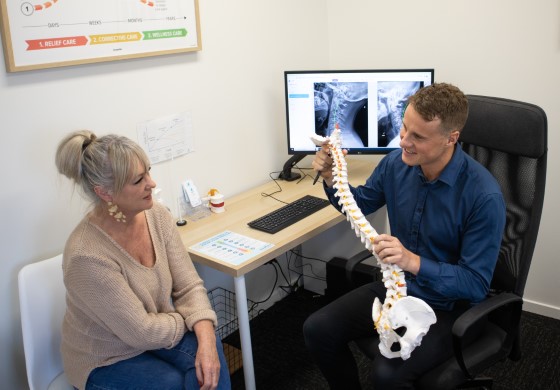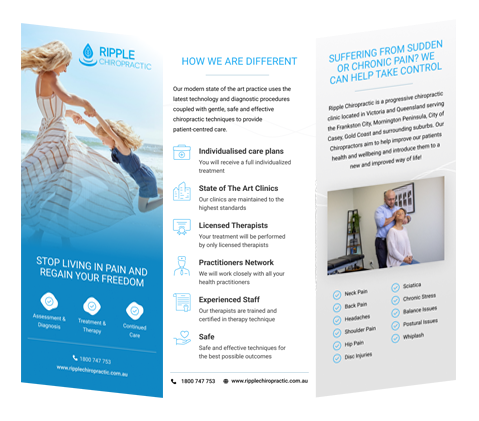Sprain Treatment
- Comprehensive History
- Health Goal Setting
- Orthopedic Exam
- Neurological Exam
- Biostructural Exam
- 3D Posture Analysis
- Range Of Motion Exam
- Referral For Diagnostic Imaging
- First Follow Up Treatment
EXCELLENTBased on 109 reviews Trustindex verifies that the original source of the review is Google.
Trustindex verifies that the original source of the review is Google. Helena Annelise2022-05-26All the chiropractors have been so helpful and their reception is friendly and personable! As someone who works 8 hours a day at a desk I am grateful to have them. Truly recommend Ripple if you are in search for a chiro to help your road to recovery. Thanks again!Trustindex verifies that the original source of the review is Google.
Helena Annelise2022-05-26All the chiropractors have been so helpful and their reception is friendly and personable! As someone who works 8 hours a day at a desk I am grateful to have them. Truly recommend Ripple if you are in search for a chiro to help your road to recovery. Thanks again!Trustindex verifies that the original source of the review is Google. Trevor Wyhoon2022-04-29Im normally not one to recommend, but this team is Fantastic!!!. They help you set goals for your care and lead you through them. Great results, cannot recommend them highly enough.Trustindex verifies that the original source of the review is Google.
Trevor Wyhoon2022-04-29Im normally not one to recommend, but this team is Fantastic!!!. They help you set goals for your care and lead you through them. Great results, cannot recommend them highly enough.Trustindex verifies that the original source of the review is Google. Laura Feddersen2022-03-25Ripple chiropractic is like no other I have experienced. The care is 10/10, the investigative work done to understand my issues was thorough. They educated me to understand how I got to this point and how we were going to correct it. I couldn't be happier at Ripple.Trustindex verifies that the original source of the review is Google.
Laura Feddersen2022-03-25Ripple chiropractic is like no other I have experienced. The care is 10/10, the investigative work done to understand my issues was thorough. They educated me to understand how I got to this point and how we were going to correct it. I couldn't be happier at Ripple.Trustindex verifies that the original source of the review is Google. Melissa Parkinson2022-02-16Highly recommend!! My family has been seeing Dr Aleks and the team at Ripple Chiropractic for many months now and we cannot be happier with the level of care and treatment we have received. We have all had amazing results and cannot thank Dr Aleks enough.
Melissa Parkinson2022-02-16Highly recommend!! My family has been seeing Dr Aleks and the team at Ripple Chiropractic for many months now and we cannot be happier with the level of care and treatment we have received. We have all had amazing results and cannot thank Dr Aleks enough.
Sprains are common injuries that occur when ligaments—strong, fibrous tissues connecting bones—are overstretched or torn. From athletes to active individuals and even those experiencing a sudden twist or fall, sprains can affect anyone.
Chiropractic care may offer a non-invasive way to manage pain, reduce swelling, and promote natural healing. For sprains, early intervention and consistent care may help prevent further injury, accelerate recovery, and support long-term joint health.
Understanding Sprains
Sprains vary in severity and are classified by “grades”:
- Grade 1 (Mild): Involves stretching of the ligament fibres, resulting in mild pain and minimal swelling.
- Grade 2 (Moderate): Characterised by partial ligament tearing, often accompanied by moderate pain, noticeable swelling, and difficulty moving the affected joint.
- Grade 3 (Severe): Indicates a complete tear of the ligament, leading to severe pain, instability in the joint, and often significant swelling. Severe sprains may require longer recovery times and intensive rehabilitation.
Sprains can occur in any joint but are most common in the ankles, knees, wrists, and hands. High-impact sports, sudden twists, or falls can lead to sprains, and understanding the risk factors for these injuries—such as previous injuries, poor conditioning, and lack of warm-up—can help with prevention.

Some of the more common types of sprains include ankle sprains, knee sprains and hand and wrist sprains.
Types of Sprains and Common Symptoms
Each type of sprain presents distinct symptoms:
- Ankle Sprains: An ankle injury is commonly caused by rolling or twisting the ankle, often resulting in an inversion sprain that impacts the anterior talofibular ligament and sometimes the posterior talofibular ligament. High ankle sprains, which involve ligaments above the ankle, are also possible and tend to take longer to heal. Symptoms include pain, swelling, and difficulty bearing weight, especially in acute ankle sprains.
- Knee Sprains: Often involve the knee ligaments, especially the ACL or MCL, due to sudden direction changes. Symptoms include pain, instability, and sometimes a noticeable “pop” at the time of injury.
- Hand and Wrist Sprains: Typically from falls where the hand is extended to break the fall. Symptoms include pain, swelling, and difficulty moving fingers or gripping objects.
Diagnosis and Treatment of Sprains
Proper diagnosis is essential to determine the severity of the sprain and the best treatment approach. Chiropractic care begins with an initial assessment to evaluate the extent of ligament damage, pain level, and potential swelling.
In cases where imaging such as magnetic resonance imaging (MRI) is required, chiropractors may refer patients to other healthcare providers.
Once diagnosed, treatment options focus on:
- Pain and Swelling Management: Chiropractors may use techniques such as manual adjustments and soft tissue therapies to support alignment and reduce inflammation.
- Joint Mobilisation: Specific techniques that may help enhance joint range of motion and support mobility.
- Guidance on Self-Care: Instructions on applying the RICE method (Rest, Ice, Compression, Elevation) during the initial stages that may help reduce pain and swelling.
Chiropractic Care for Sprains
Chiropractic care may help address both immediate symptoms and recovery. Treatment approaches may include:
- Soft Tissue Techniques: Therapies targeting soft tissues that may help release muscle tension around the injured area, support blood flow, and assist the healing of fibrous tissue. These techniques may also help prevent the formation of scar tissue, which could support mobility and flexibility over time.
- Rehabilitation Exercises: Tailored exercises that may help restore strength and stability in the affected joint. These exercises, often guided by chiropractors, may help address specific concerns, such as difficulty walking after an ankle sprain, to support safe and gradual recovery.
- Pain Management Techniques: Chiropractors may guide patients on lifestyle modifications and therapeutic stretches that could help manage pain without medication. Techniques like using an elastic bandage for support or incorporating gentle movements help alleviate discomfort in the torn ligament and injured tissues.
By addressing pain, reducing swelling, and restoring normal joint movement, chiropractic care may help prevent re-injury and promote healing for the long term.
Stop Living in Pain and Regain Your Freedom
Benefits of Chiropractic Care for Sprains
Chiropractic care may provide supportive care to help individuals recovering from sprains:
- Non-Invasive Pain Relief: Chiropractic techniques may offer pain management approaches without medications.
- Movement Support: Mobilisation exercises and adjustments may help support joint range of motion.
- Prevention of Scar Tissue: Soft tissue therapies may encourage proper healing, which helps reduce the buildup of scar tissue that can limit flexibility.
- Promotes Long-Term Joint Health: Regular care may help build stronger, more flexible ligaments and joints, reducing the risk of future sprains.

Chiropractic care may help in addressing both immediate symptoms and recovery.
Preventing Sprains
Preventing sprains involves strengthening the muscles and ligaments around vulnerable joints. Tips for prevention include:
- Warm-Up and Stretch: Always warm up before physical activity to prepare your muscles and joints for movement.
- Strengthen Muscles: Strengthening exercises, especially for the lower legs, ankles, and core, can improve balance and stability.
- Wear Proper Footwear: Supportive, activity-appropriate footwear can reduce the risk of twisting injuries, particularly during high-impact activities.
Practising balance exercises, especially for the ankles and knees, can also significantly reduce the likelihood of future sprains. Bracing or taping is also helpful, especially during activities that require sudden movement changes.
Why Choose Ripple Chiropractic for Sprain Treatment
Ripple Chiropractic understands the needs of active individuals and tailors sprain treatment plans to address each person’s unique needs.
Our chiropractors use comprehensive assessments to create personalised care plans that address immediate pain relief and long-term healing. Through chiropractic care, patients can recover faster, build joint strength, and return to the activities they love with confidence.
Individualised care plans
You will receive a full individualised treatment
State of The Art Clinics
Our clinics are maintained to the highest standards.
Licensed Therapists
Your treatment will be performed by only licensed therapists
Practitioners Network
We will work closely with all your health practitioners
Experienced Staff
Our therapists are trained and certified in therapy technique
Safe
Safe and effective techniques for the best possible outcomes.
How to Schedule an Appointment
If you want to schedule an appointment to see a chiropractor for sprains, you can give us a call on (03) 9864 1819 or you can fill out our online booking form.
FAQs
If you have any more questions about sprains treatment, please don’t hesitate to contact us today. In the meantime, check out our most frequently asked questions below which may provide the additional information you’re looking for.
How long does an ankle sprain take to heal?
The recovery time for an ankle sprain depends on its severity. Mild sprains typically heal within a few weeks, while moderate or severe sprains may take longer and might require rehabilitation to restore joint strength and mobility. For acute ankle sprains, immediate care is essential to prevent long-term issues, and following a structured recovery plan can reduce healing time.
What’s the difference between sprains and strains?
How can chiropractic care help with an injured ankle?
Chiropractic care may be beneficial for an injured ankle by providing approaches to help manage pain and support joint mobility. Techniques such as joint mobilisation and soft tissue therapy may help reduce discomfort and support the natural healing process. Chiropractors often work alongside other healthcare providers for comprehensive care, especially for severe or chronic ankle sprains.
When should I seek help for a severe sprain?
A severe sprain often involves considerable pain, swelling, and instability in the injured joint. Seeking help from a healthcare provider, including a chiropractor or physical therapist, is advisable to prevent complications and ensure proper healing. Severe sprains may require extended treatment and rehabilitation to strengthen the ankle ligaments and prevent future injuries.
Can most sprains be treated at home or is professional help needed?
Most sprains, particularly mild ones, can be managed at home with the RICE method (Rest, Ice, Compression, Elevation) to reduce swelling and pain. However, for an acute ankle sprain or if symptoms worsen, it’s advisable to seek professional care. A healthcare provider can provide a more accurate diagnosis, assess whether it’s a sprain or strain, and suggest tailored exercises for recovery.
General Information Disclaimer: The content provided here is for informational purposes only and is not intended as medical advice, diagnosis, or treatment. Always seek the advice of your health professional with any questions you may have regarding a medical condition. The information on this site is general in nature and may not reflect current medical developments or research. Your reliance on any information provided by this site is solely at your own risk.
Grab Our New Patient Offer Today
Consultation + 1st Treatment

We are offering a special price for your consultation + 1st treatment which will include all of the following:
- Comprehensive history including chief complaint, trauma and medical history.
- Health goal setting
- Orthopedic exam
- Neurological Exam
- Biostructural Exam
- 3D posture analysis
- Range of motion exam
- Referral for diagnostic imaging if clinically appropriate
- First follow up treatment


